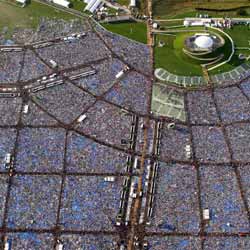 A recent post at the wonderful Pray Tell blog highlighted an intriguing question: how would you consecrate for one and a half million people at a Eucharist? Is the Eucharist appropriate for such a huge gathering?
A recent post at the wonderful Pray Tell blog highlighted an intriguing question: how would you consecrate for one and a half million people at a Eucharist? Is the Eucharist appropriate for such a huge gathering?
Should a Eucharist be celebrated if there is no way to communicate those who would like to receive? Fr. Allan McDonald writes of his experience at a papal Eucharist where over a million communicants were planned for, over a million wafers were consecrated by people holding wooden salad bowls, full of wafers, covered with cellophane. Only half the expected numbers turned up:
“Much to my shock, we gathered behind the altar after Holy Communion and “dumped” our left over consecrated hosts into large, black plastic garbage bags. We were told that these hosts would be distributed to the various churches and institutions in Washington.”
Another spoke about in Madrid it appearing that only clergy received communion – such clericalism, even if only perceived, is certainly a serious issue. Many will remember the funeral Mass for Pope John Paul II, “Well after the words of institution (consecration), there were lines of priests still running out the doors of St peters trying to stand in rows along the sides of the altar. I remember feeling uncomfortable about it at the time. Later the priests also started to run off to their communion stations before the Eucharistic prayer had ended. At some of these large televised masses, I’ve even noticed communion being distributed before the agnus dei has started or the pope’s communion. Surely, rubically inconsistent?”
Another commenter wrote about his being unclear whether priests were concelebrating with the pope or offering a “synchronised Mass”.
Not unrelated, is a possible reflection about large congregations not being suitable for a focus on the Eucharist. Anglican (Episcopalian), Roman Catholic, Eastern Orthodox, etc., communities that have the Eucharist as central, do not tend towards the mega-church phenomenon – and possibly appropriately so?




A Mass of millions seems rather counterintuitive to what the Eucharist is meant to be: a meal that is a means of communion with God and one another. The larger the throng, the less genuine or palpable that sense of communion is likely to be in a sea of distance and anonymity. Rather, it denegrates into a public spectacle, a demonstration of perceived “strength in numbers” that may register in the world’s eyes, so often impressed by statistics, but which seems at odds with the God who chose weakness and foolishness to confound the “might” and “wisdom” of the world (1 Corinthians 1:25, 27-29). And the dumping of leftover consecrated bread into garbage bags, even with the intention of distributing them at Eucharistic assemblies at other churches, is shockingly irreverent and cavalier — particularly given that Roman Catholicism once had (and still does, in some quarters) the practice of enshrining the Eucharistic bread in monstrances of gold and precious gems for public display and adoration, contrary to the Eucharist’s intended purpose: eating and consumption.